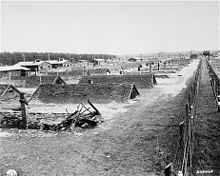Kaufering concentration camp

Kaufering concentration camps were a network of subsidiary camps of the Dachau concentration camp.
With the intensification of the Allied air war against German industrial and military enterprises after 1943, the German Armaments Ministry and the Schutzstaffel (SS) agreed to accelerate construction of massive underground factories, using large numbers of conscripted laborers and concentration camp prisoners. Hundreds of satellite camps attached to major Nazi concentration camps were established throughout the German Reich in 1944 and 1945. Inmates were compelled to hollow out the sides of mountains or caves for immense systems of tunnels and factories that would be secure from Allied bombs. Those who survived these tasks were often used to build new weaponry, such as the Messerschmitt Me 262 jet fighter, and V-2 ballistic missiles.
In Bavaria, two major camp systems, Mühldorf and Kaufering, were set up as subcamps of the Dachau concentration camp. Its inmates provided the labor necessary to build subterranean facilities for fighter aircraft production in the Landsberg area. The region was chosen in part because of its favorable geological composition for the construction of mammoth underground installations, which were to be insulated by 9 to 15 feet thick concrete walls. To house the concentration camp prisoners, the SS created camps near the proposed industrial sites. At the Kaufering and Mühldorf camps, prisoners often slept in poorly heated and badly provisioned earthen huts, which were partially submerged in the soil and covered with earth to disguise them from the air. The larger of Kaufering's 11 camps each contained several thousand prisoners, the vast majority of whom were Jews. Disease, malnutrition, and the brutal conditions in the workplace and in the camps took its toll on the inmates, resulting in a high mortality rate.
As U.S. armed forces approached the Kaufering complex in late April 1945, the SS began evacuating the camps, sending the prisoners on death marches in the direction of Dachau. Those inmates who could not keep up were often shot or beaten to death by the guards. When US troops entered Kaufering IV, they found 360 dead prisoners including the still smoldering corpses of 86 prisoners who died in their quarters when the SS set fire to them because these men were too ill or weak to move. An early visitor to the camp was CIC Agent J.D. Salinger who was traumatized by the horrors of the camp. He later said, "You never really get the smell of burning flesh out of your nose entirely, no matter how long you live."
Kaufering Lager IV was discovered by scouts of the Twelfth Armored Division around noon on April 27, 1945. Colonel Edward Seiller took control of the camp and had some 250 civilians from the nearby town of Landsberg brought to the camp and made them bury the dead prisoners. These 360 dead repose in a cemetery located where the roll-call area (Appell Platz) of the camp used to be, that is about a mile south of the village of Hurlach.[1]
In popular culture
A reconstruction of the camp was shown in the "Why We Fight" episode of Band of Brothers. But the camp was not liberated by the 101st Airborne as shown in the movie. Actually, it was not "liberated" at all because the SS had fled before US troops arrived. The American troops encountered only a very few prisoners wandering around in the vicinity of the abandoned camp.
See also
Further reading
- Colonel Julien Saks, "GI's Discover the Holocaust," in HELLCATS, ed. Ken Bradstreet (Paducah, KY: Turner Publishing, 1987), 118.
References
- ↑ "Kaufering". United States Holocaust Memorial Museum. Retrieved 23 February 2015.
External links
- European Holocaust Memorial - a monument ensemble against racism and totalitarianism at the place of the crime - under the executive management of European Holocaust Memorial Foundation
- Kaufering Kaufering Online Memorial
- The Liberation of the Kaufering IV Hurlach camp, by Japanese-American Nisei troops of the 522nd Field Artillery Battalion
Notes and References
- Kaufering USHMM